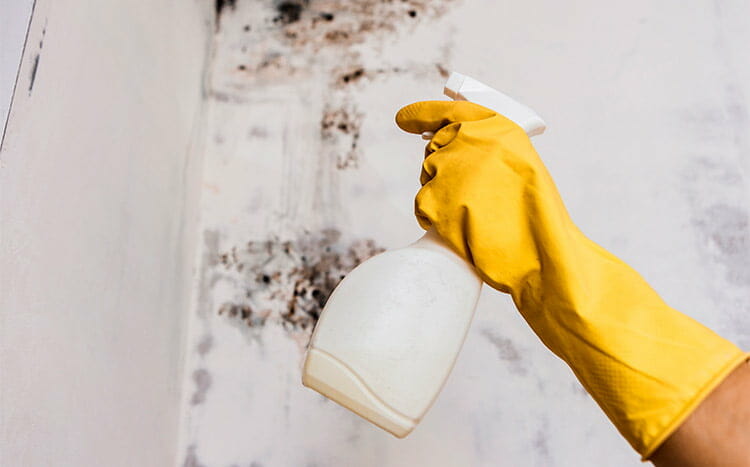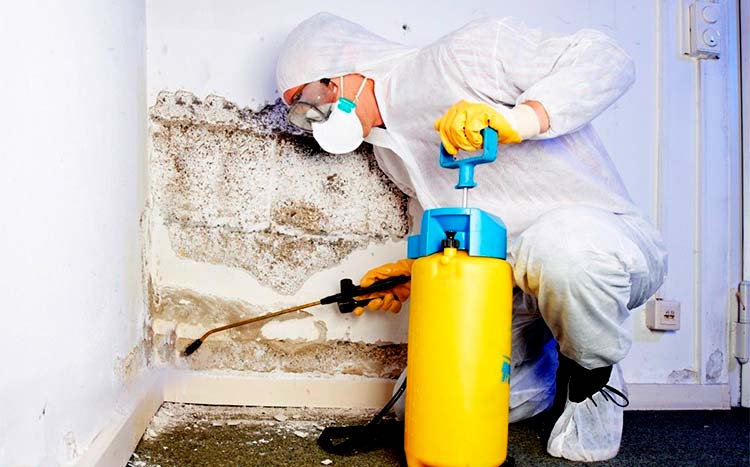Several methods exist for eliminating mold in your basement, and using a spray is often recognized as a simple and commonly employed technique.
The most popular sprays to kill basement mold are Vinegar, baking soda, bleach and tea tree oil. Vinegar has proven to be an effective mold killer, with studies showing that it kills up to over 80% of mold species.
A baking soda solution, tea tree oil, diluted bleach, and commercial-grade mold killers are also effective at getting rid of mold and can thus be sprayed to kill basement mold.
Here is what you should know about mold in the basement and what you can do about it.

What you can use:
The steps that you have to follow in order to remove mold from your basement are generally similar, independent of which mold-killing solution you choose to use. The differences tend to only arise in how to prepare the mold-killing solution and how long you have to let it sit before rinsing or drying it off.
After sealing off the basement to keep mold spores from spreading to the rest of the house, discarding mold-affected items, scraping off any visible mold off the affected surfaces, and vacuuming the surfaces with a vacuum that has been fitted with a HEPA filter, you will then have to prepare the solution that will actually kill the mold and then apply it.
The following are the most effective solutions/chemicals that you can use.
1. Vinegar
Vinegar doesn’t need to be diluted or mixed with any other compound in order to be effective. As a result, all you have to do is to pour white vinegar into a spray bottle. Use the spray bottle to spray the surface with the solution and then let it sit for an hour. Thereafter, use a dry cloth to get rid of any excess solution and then leave it to dry.
2. Baking Soda
In order to use baking soda, you will start by placing two tablespoons of baking soda in a bottle. Add two cups of water to the baking soda and then shake it well. Pour the resulting solution into the spray bottle and then soak the surface with it. Scrub the surface with a bristle brush, and then give the solution time to work — an hour is enough.
After an hour has elapsed, spray the area with a little more of the solution and then wipe off any excess solution from the surface by using a dry towel.
3. Bleach
For bleach, you will start by pouring a cup full of bleach into a container. Add a gallon of water, and then stir. Thereafter, fill a spray bottle with the resulting solution.
Spray the diluted bleach onto the moldy surface and then leave it for about 20 minutes. This should give the bleach enough time to act. Thereafter, wipe away any excess solution and any traces of mold — using paper towels will do.
4. Tea tree oil
In order to prepare an effective tea tree oil solution for killing mold, add one teaspoon of the oil to a cup of water. Pour the resulting mixture into a spray bottle and then shake it well. Thereafter, all that will be left to do will be to spray the affected area with the solution, let it sit for about 60 minutes, and then dry off the surface with a dry cloth.
What home remedies can you use for mold in basement?
You can get rid of mold from your basement by using the following home remedies:
- White vinegar
- Drops of tea tree oil
- Diluted chlorine bleach
- Undiluted hydrogen peroxide
- Baking soda solution

What can you use to kill mold instantly?
A mixture of vinegar and baking soda can be used to kill mold within an hour. Diluted chlorine bleach, and commercial chemicals for killing mold like Concrobium Mold Control, can also kill mold fast.
Is vinegar or hydrogen peroxide better for mold?
Vinegar is better for mold removal than hydrogen peroxide. It has been consistently shown to kill over 80% of mold species. And while hydrogen peroxide can also be used to kill and remove mold, it is not as effective as vinegar.
What prevents mold spores from spreading?
When you are cleaning mold, it is important to take precautions in order to keep mold spores from spreading. The following are the most effective ways of doing so.
- Spritzing the moldy surface with water before scrubbing. The added moisture content helps to settle the dust and mold spores. This keeps them from getting airborne when you start scrubbing.
- Using a vacuum with a HEPA filter. Since you will have to vacuum the surface before cleaning it, it is always a good idea to use a vacuum that has been fitted with HEPA filters. This is because these are the only filters that are good enough to guarantee that all the mold spores will be trapped. As a result, the vacuum won’t end up spreading it all over your home.
- Turning off the air conditioning system. Your air conditioner works by drawing in air from your home, heating or cooling it, and then distributing it back into the home. If during the clean-up process your air conditioner is on, it can end up drawing air with mold spores from your basement and then spread it into other rooms.
- Covering registers and vent openings with clothing. Doing so helps to prevent mold dust from infiltrating your home’s duct system. This will go a long way towards keeping the mold from spreading.
- Wearing discardable clothing and shoes when cleaning. As you clean, mold spores are going to land on your clothes. If you don’t discard them, the chances of spreading the spores in your home will be high. Therefore, wearing disposable or old clothing can help to reduce the risks of spreading the mold spores.
- Placing collected dust and waste in air-tight ziplock bags. And after you do so, you should make sure that you immediately throw the closed ziplock plastic bags into the dustbin.
How do professionals remove mold?
Professionals usually start the mold removal process by first conducting a site visit. They examine the home in order to check the extent of the mold growth. And they may then take a sample for testing in order to know what type of mold they will be dealing with.
Thereafter, they will seal the area that they have to work on in order to keep mold spores contained. They will then scrape off any mold from surfaces that they have to clean. And then they will apply a strong commercial grade mold killing chemical. They will leave it for a while, rinse it off, and then leave the area to dry.
They will then perform cleanup services. And after they are done, they may then carry out a mold test in order to ensure that the work that they did was effective in getting rid of mold.
Can I remove black mold myself?
Yes, you can remove black mold yourself if it is covering a small area. Vinegar and other professional-grade commercial cleaners can kill black mold, and so you can use them to remove the mold.
However, it is always advisable that you seek professional help as soon as you notice black mold. This is because the mold can be toxic black mold that usually produces mycotoxins.
This mold can be dangerous and so you may not want to remove it yourself in order to minimize exposure to its spores. Using a professional will also guarantee that it won’t come back, and is thus a great idea.
When to call a professional?
You should call a professional if:
- The mold in your house is more than 10 square feet. In such a case, the chances of you cleaning it properly in such a way as to avoid regrowth are low. Using professional services is thus recommended.
- You find black or green mold in your home. This is because there are chances that this mold is toxic. By opting for a professional, you will minimize the risks of accidentally spreading its spores. You also minimize your exposure to its toxicity
- The mold growth is extensive and has invaded your air conditioning systems, your home’s insulation, and other hard-to-reach areas like crawl spaces.
FAQ's
What can cause mold in the basement?
Pipe leaks, basement flooding, poor ventilation, and high humidity can all cause mold in the basement.
Is mold in basement dangerous?
Mold in the basement can be dangerous in the sense that it can cause extreme allergic reactions in people who are allergic to mold spores. In people with weak immune systems or those with pre-existing respiratory complications, the presence of mold can have serious consequences. And in cases where you are dealing with toxic black mold, then the resulting medical complications can prove to be extremely harmful.
However, there is really no difference — in terms of danger — between the mold that grows in your basement and the one that grows in other areas like the bathroom.
How to test your house for mold?
The first sign of the presence of mold in your home is a musty smell. This is usually enough to give you the general direction of the mold growth. Generally, the closer you get to the mold growth, the stronger the musty smell will get.
The presence of white, green, black, blue, yellow, or grey stains or discoloration should then be able to reveal the possible mold growth. At this point, you will then have to perform a mold test in order to tell whether it is mold or whether it is simply dirt.
To do so, pour a little amount of bleach into a cup. Dilute it with water. And after you are done, dip a swab into the solution. Use the swab to then apply a small amount of the diluted bleach onto the surface. If it is mold or mildew, it will brighten up almost instantly. But if it does not, then that is simply dirt.
At-home mold testing kits also exist. These kits usually come with instructions on how to collect and bag mold samples. And after you do so, all you have to do in order to know whether you have a mold problem is to send the sample to the address that is specified and then wait for the results.
However, the easiest way is to simply contact a professional mold testing company. When you hire them, they will come to your house, collect samples, test them, and then give you the results of their findings.







